If you have always wanted to grow banana plants but thought you lived in a climate that’s just too cold – you need to try your hand at growing cold hardy banana plants!
Most banana plants that produce the fruit you get at grocery stores are grown in warm, tropical regions. And although there are many of those regions around the world (some 150 to be exact!), there are a lot of places that are simply too cold for traditional banana plants.
However, there are some banana plants that have been adapted to grow in colder climates. These cold hardy varieties, often called Japanese Bananas, are members of the Musa genus. And as luck will have it, you can grow them all throughout most of the United States.
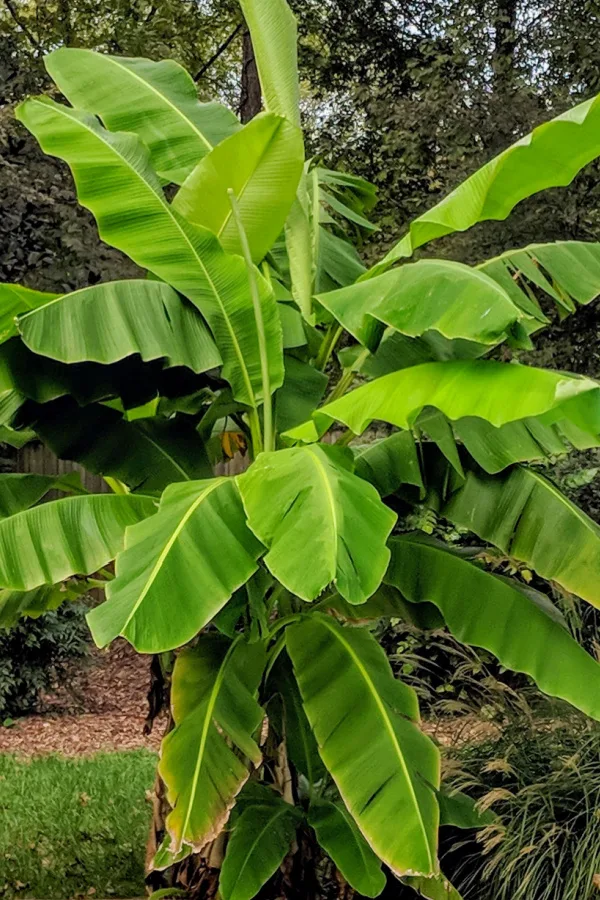
These plants are usually cold hardy in USDA Growing Zones 5 through 11. Many can even survive in warmer zones as evergreens with occasional temperatures down to 25º Fahrenheit (-4º Celsius). In colder locations, the plants will die back only to regrow again the following summer. However, you can grow them in any location in pots or containers.
Cold hardy banana plants feature the iconic large, smooth, and waxy leaves and the overall appearance of typical banana plants. This allows them to give off a beautiful, tropical feel wherever you plant or grow them. But there are a few differences and care tips to keep in mind when growing cold hardy banana plants.
Are Cold-Hardy Bananas Edible?
Tropical banana plants are normally grown for the harvesting of their distinctive soft and sweet yellow or green fruit. While yellow bananas are usually the norm, you can even find ripe, edible banana varieties with peels of black, purple, red, or pink.
But cold hardy banana plants are grown more for their foliage and visual appeal as opposed to their fruit. The fruit is still technically edible and safe to consume, but most of them have an unpleasant taste and texture.
The fruit from cold hardy banana plants has more of a starchy makeup and a smaller content of sugar, making them rather bitter and unappealing (pun intended!). They are also harder in texture and drier than typical store-bought bananas that most are used to.
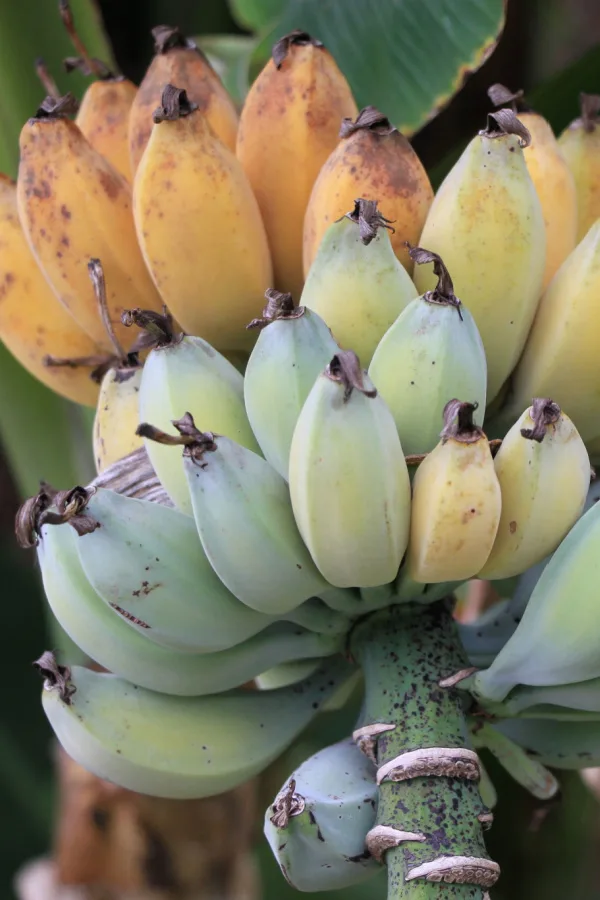
Some varieties are a bit more palatable than others, so be sure to do your research if semi-edible fruit is part of your growing outcome. Cooking may help some varieties, but you are better off leaving the fruit on the plant for decoration as opposed to consumption.
How To Plant, Grow, And Maintain Cold-Hardy Banana Plants
Planting Cold-Hardy Banana Plants
While you can grow them from seed, most cold-hardy banana plants grow best from rhizomes. Unlike store-bought bananas that have been adapted to be seedless, the fruit of cold hardy banana plants is full of seeds. You can save them for starting new plants, but keep in mind that it will take a long time for them to germinate and grow.
When grown from rhyzomes, cold hardy banana plants are fast growing. In fact, they can reach full mature height in as little as one growing season!
Unfortunately, while they do grow quickly, they can take between 12 to 24 months to produce fruit. That means that for locations where the plant dies back during the winter months, you likely won’t be able to enjoy the addition of growing fruit. That’s not really a big disadvantage though since the stunning foliage is the show stopper with these plants.
Container Plants
For growing indoors in containers, you can transplant cold hardy banana plants at any time. They are a perfect addition to grow next to other fruit trees in your home like dwarf orange trees or lemon trees and can really add a visual statement. They can be kept indoors year-round or you can bring them in only during the cold winter months if preferred.
Choose a container at least 24” wide to allow for growth and avoid repotting. Ensure that your container has sufficient drainage holes to allow the excess water to drain out and help avoid root rot. Pick a potting soil that is fertile and drains well. Keep the soil moist but not overly saturated.
Place the Japanese banana plant as close as possible to a south or east-facing window or use a grow light to supplement the sunlight. The plants will need at least 6 to 8 hours of daylight each day. Avoid placing the container near drafts or heater vents.
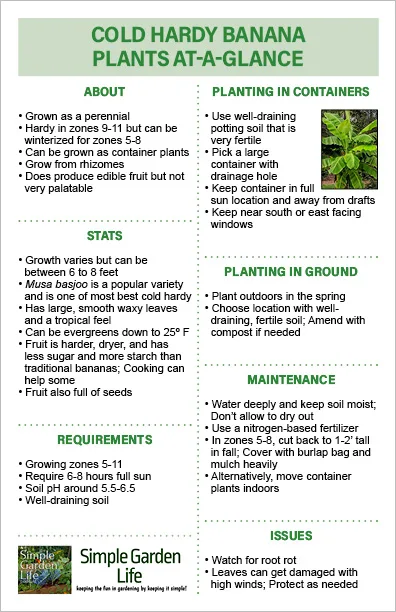
Outdoor Planting
The best time of year for planting the rhizomes is in the spring for outdoor growing. Choose a location with full sun, about 6-8 hours a day. Avoid placing plants near taller trees or buildings that might block the sunlight.
Pick an area that has well-draining soil that doesn’t have water pooling after heavy rains. Amend the soil with plenty of aged compost. Aim for a pH of around 5.5 to 6.5 for best results in both situations.
Create a hole that is a few inches larger and wider than the rhizome. Add in a few inches of compost and then your rhizome. Backfill with soil and lightly tamp down. Water deeply. You can add a few inches of light mulch to help retain moisture.
Long-Term Care – How To Grow and Maintain Cold Hardy Banana Plants
Watering
When cold hardy banana trees are actively growing (during the spring and summer months), they will require frequent watering. Water them deeply and as much as three to four times a week. Do not allow the soil to completely dry out. You can usually cut back on watering during the colder seasons.
The amount you water will vary on several factors. Conditions like whether you have the plant indoors or out, your weather, the soil used, etc. will all make a difference in how often you will need to water. Let your soil be your indicator on when to water. If it is dry an inch below the surface, it’s time to water.
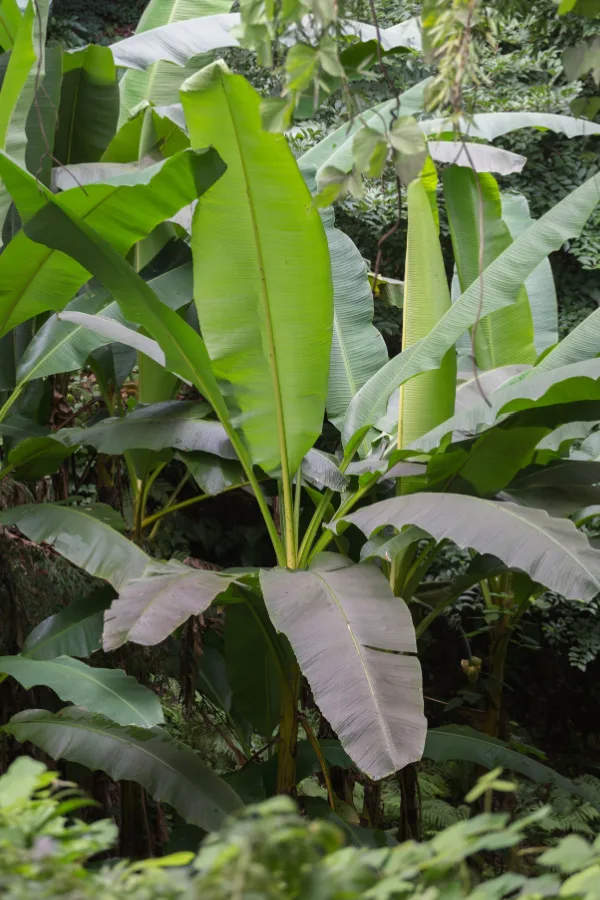
Fertilizing
Fertilize cold hardy banana plants every few weeks during the growing season. Choose an organic, all-purpose fertilizer with a nitrogen base. They even have commercial fertilizer that is geared toward banana plants. Stop fertilizing in the fall and winter months. Using compost tea is another great alternative to commercial fertilizer. (Product Link: Grow More Banana Fertilizer)
Winterizing
In the warmer growing zones 9-11, you can treat cold hardy banana plants as evergreen plants year-round. Just cut off any dying leaves to help promote new growth. Leaves will likely start to drop during the winter months but more will quickly grow back during the growing season.
For those in the colder growing zones 5-8, you will need to overwinter the banana plants. Once the temperatures drop below 40º Fahrenheit (4º Celsius), it’s time to prepare them for overwintering. When you overwinter them properly, some cold-hardy varieties like Musa basjoo can survive winter temperatures down to -10º Fahrenheit (-23º Celsius).
As the plants start to die back, cut back their leaves until the plant is only around one to two feet tall. Cover the remaining plant with a thick layer of organic mulch like straw or shredded leaves.
You can also wrap the plant in a burlap bag and add your mulch. This will help to protect the soil and the plant from colder temperatures. Once the weather warms up again in spring, you can remove the mulch as well as the burlap bag, if used.
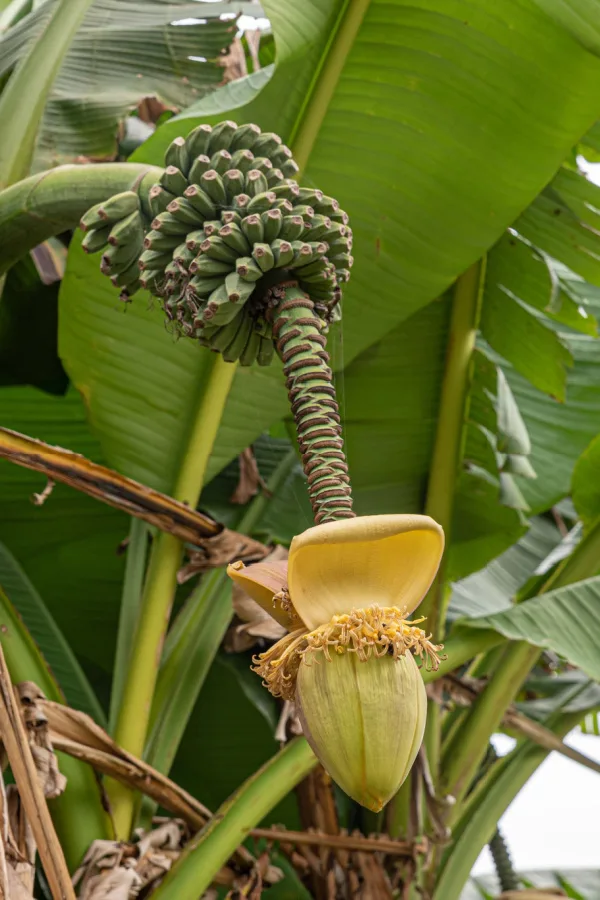
If you prefer, you can bring any container banana plants indoors to ride out the wintertime inside and then move them back outside in the spring. Just be sure to keep them near a sunny window or grow light.
Pests & Issues
The main issue to watch out for with your cold-hardy banana plant is root rot. Since they like to have moist soil, this can be an issue. Ensure you are planting into well-draining soil and avoid standing water.
Another issue with these plants is wind damage. Their large leaves can easily become damaged if they are in a location that gets high winds. Avoid planting or placing them near locations that are overly windy.
To Conclude…
While they might not produce those smooth, delicious bright yellow bananas you find in the market, you can still enjoy the cold-hardy banana plant’s beauty and tropical feel no matter where you live!
Follow Our Facebook Page For Even More Great Tips! Simple Garden Life Facebook Page
Simple Garden Life is a website dedicated to keeping gardening fun, simple and enjoyable! We publish two new articles each week along with a new garden podcast episode every two weeks. This article may contain affiliate links.
Feel free to download, print out, or save our Cold Hardy Banana Plant At-A-Glance sheet. It will print on a half page, but you can scale if needed.
